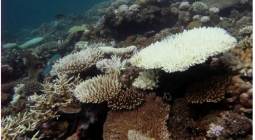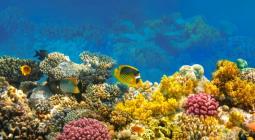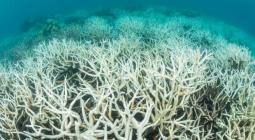‘Literally off the charts’: global coral reef heat stress monitor forced to add new alerts as temperatures rise
Three new levels added by US Coral Reef Watch after ‘extreme’ unprecedented heat, with highest alert warning of ‘near complete mortality’
The world’s main system for warning about heat stress on the planet’s coral reefs has been forced to add three new alert categories to represent ever-increasing temperature extremes.
The changes introduced by the US government’s Coral Reef Watch program come after reefs across the Americas were hit by unprecedented levels of heat stress last year that bleached and killed corals en masse.
“We are entering a new world in terms of heat stress where the impacts are becoming so pervasive that we had to rethink how we were doing things,” the Coral Reef Watch director, Dr Derek Manzello, told the Guardian.
Coral reefs are considered one of the ecosystems most at risk from global heating, driven by burning fossil fuels and deforestation, and are home to a quarter of all marine species.
Excessive heat can cause corals to separate from the tiny algae that give them their colour and much of their nutrients. Bleaching can kill corals, but scientists say even those that survive are more susceptible to disease and struggle to reproduce.
Coral Reef Watch, hosted by the National Oceanic and Atmospheric Administration, previously issued warnings for coral reefs in four stages, with the highest, alert level 2, suggesting that “severe bleaching and significant mortality [is] likely”.
Now the program has added three further alert levels to a program used by scientists, conservationists, marine park managers and citizen scientists around the world to understand the conditions being faced by coral reefs in their areas.
Underlying the warning system is a measure of the amount of accumulated heat stress that corals are facing at any given time, known as degree heating weeks.
For example, 1 DHW is accumulated if corals are subjected to temperatures that are 1C above the usual maximum for seven days.
Coral Reef Watch’s old system gave the highest rating at 8 DHWs or above, but last year in the northern hemisphere summer, large areas of reef across several countries experienced heat stress well beyond that highest rating, surpassing more than 20 DHWs in some areas.
“We started to ask what this meant for the ecosystems at these extreme levels,” Manzello said. “Did reef managers need more information for when things got so extreme?
“Our old product was missing all that information and it wasn’t reflecting just how extreme it was getting.
“We know that coral mortality starts at about eight degree heating weeks and we know that now things are getting catastrophic – greater than 20 degree heating weeks.
“When you exceed a DHW value of 20 it is analogous to a Category Five cyclone, with unbelievably severe, drastic damage. It’s the worst case scenario.”
Coral Reef Watch’s new alert level 3 represents DHWs of between 12 and 16; alert level 4 from 16 to 20, and alert level 5 for anything above 20.
The text attached to the warning levels has also changed to reflect how the severity of bleaching and the risk of corals dying can differ depending on their sensitivity to heat.
At alert level 5, the warning says there is a risk of “near complete mortality” of all corals.
Until the changes were introduced just before Christmas, the warning system had remained unchanged since it launched in 2009. The underlying assumptions around the risks from different levels of heat stress had been in place since 1997.
Dr David Wachenfeld, who leads research on reef ecology and monitoring at the Australian Institute of Marine Science and is a former chief scientist at the Great Barrier Reef Marine Park, said Coral Reef Watch was the “go-to” tool for the global coral reef community.
“The events in the northern hemisphere summer last year were without question extreme,” he said.
“Thermal stress there was unprecedented by a very large margin. I commend NOAA for acting so quickly and acknowledging that the system we have been using since the late 20th century was no longer fit for describing the extremes we’re seeing in the early 2020s.”
Wachenfeld said the warning levels were a good guide, but reefs could react differently to the same level of heat stress depending on the mix of species or the history of bleaching in that area.
“Having to adjust our systems like this is an inevitable consequence of the climate changing,” he said. “We are in uncharted territory in terms of heat impacts on reefs.”
Richard Leck, head of oceans at WWF-Australia, said: “What this new system shows is that ocean temperatures and the risks to coral reefs are literally off the charts. It’s also an incredibly powerful reminder that global heating is impacting our oceans in the here and now in ways unimaginable only a decade ago.”
Prof Tracy Ainsworth, vice-president of the International Coral Reef Society, said ongoing heat stress events were rare a decade ago. “But now we don’t just talk about bleaching events, but mortality events – and that’s what this change represents.”
Cover photo: Last year in the northern hemisphere summer, large areas of coral reef across several countries experienced heat stress well beyond the highest existing rating. Photograph: Joseph Prezioso/AFP/Getty Images






